Chapter: Introduction to the Design and Analysis of Algorithms : Fundamentals of the Analysis of Algorithm Efficiency
Mathematical Analysis of Non recursive Algorithms
Mathematical
Analysis of Non recursive Algorithms
In this section, we systematically apply the
general framework outlined in Section 2.1 to analyzing the time efficiency of
nonrecursive algorithms. Let us start with a very simple example that
demonstrates all the principal steps typically taken in analyzing such
algorithms.
EXAMPLE 1 Consider
the problem of finding the value of the largest element in a list
of n numbers. For simplicity, we
assume that the list is implemented as an array. The following is pseudocode of
a standard algorithm for solving the problem.
ALGORITHM MaxElement(A[0..n − 1])
//Determines the value of the largest element in a given array
//Input: An array A[0..n − 1] of real numbers
//Output:
The value of the largest element in A maxval ← A[0]
for i ← 1 to n − 1 do
if A[i] > maxval maxval ← A[i]
return maxval
The
obvious measure of an input’s size here is the number of elements in the array,
i.e., n. The operations that are going to
be executed most often are in the algorithm’s for loop. There are two operations in the loop’s body: the
comparison A[i] > maxval and the assignment maxval ← A[i].
Which of
these two operations should we
consider basic? Since the comparison is executed on each repetition of the loop
and the assignment is not, we should consider the comparison to be the
algorithm’s basic operation. Note that the number of comparisons will be the
same for all arrays of size n;
therefore, in terms of this metric, there is no need to distinguish among the
worst, average, and best cases here.
Let us
denote C(n) the number of times this
comparison is executed and try to find a formula expressing it as a function of
size n. The algorithm makes one
comparison on each execution of the loop, which is repeated for each value of
the loop’s variable i within
the bounds 1 and n − 1, inclusive. Therefore, we get
the following sum for C(n):


Here is a
general plan to follow in analyzing nonrecursive algorithms.
General
Plan for Analyzing the Time Efficiency of Nonrecursive Algorithms
Decide on
a parameter (or parameters) indicating an input’s size.
Identify
the algorithm’s basic operation. (As a rule, it is located in the inner-most
loop.)
Check
whether the number of times the basic operation is executed depends only on the
size of an input. If it also depends on some additional property, the
worst-case, average-case, and, if necessary, best-case efficiencies have to be
investigated separately.
Set up a
sum expressing the number of times the algorithm’s basic operation is executed.
Using
standard formulas and rules of sum manipulation, either find a closed-form
formula for the count or, at the very least, establish its order of growth.
Before
proceeding with further examples, you may want to review Appen-dix A, which
contains a list of summation formulas and rules that are often useful in
analysis of algorithms. In particular, we use especially frequently two basic
rules of sum manipulation

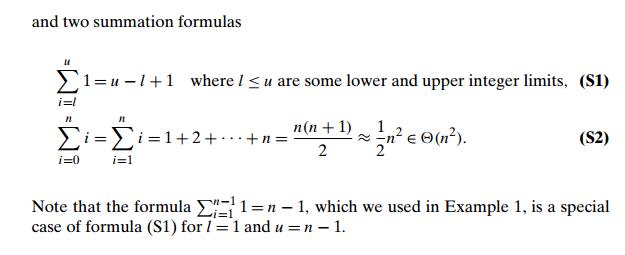
EXAMPLE 2 Consider
the
element
uniqueness problem: check whether all the elements in a given array of n elements are distinct. This
problem can be solved by the following straightforward algorithm.
ALGORITHM UniqueElements(A[0..n − 1])
//Determines
whether all the elements in a given array are distinct //Input: An array A[0..n − 1]
//Output:
Returns “true” if all the elements in A are
distinct // and “false” otherwise
for i ← 0 to n − 2 do
for j ← i + 1 to n − 1 do
if A[i] = A[j ] return false return true
The
natural measure of the input’s size here is again n, the
number of elements in the array. Since the innermost loop contains a single
operation (the comparison of two elements), we should consider it as the
algorithm’s basic operation. Note, however, that the number of element
comparisons depends not only on n but also
on whether there are equal elements in the array and, if there are, which array
positions they occupy. We will limit our investigation to the worst case only.
By definition, the worst case input is an array for which the number of element comparisons Cworst (n) is the largest among all arrays of size n. An inspection of the innermost loop reveals that there are two kinds of worst-case inputs—inputs for which the algorithm does not exit the loop prematurely: arrays with no equal elements and arrays in which the last two elements are the only pair of equal elements. For such inputs, one comparison is made for each repetition of the innermost loop, i.e., for each value of the loop variable j between its limits i + 1 and n − 1; this is repeated for each value of the outer loop, i.e., for each value of the loop variable i between its limits 0 and n − 2. Accordingly, we get
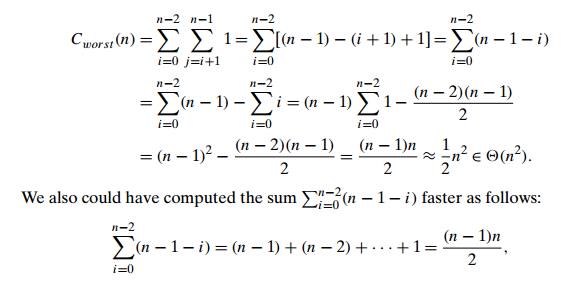
where the last equality is obtained by applying summation formula (S2). Note that this result was perfectly predictable: in the worst case, the algorithm needs to compare all n(n − 1)/2 distinct pairs of its n elements.
EXAMPLE 3 Given two n × n matrices A and B, find the time efficiency of the definition-based
algorithm for computing their product C = AB. By
definition, C is an n × n matrix whose elements are
computed as the scalar (dot) products of the rows of matrix A and the columns of matrix B:
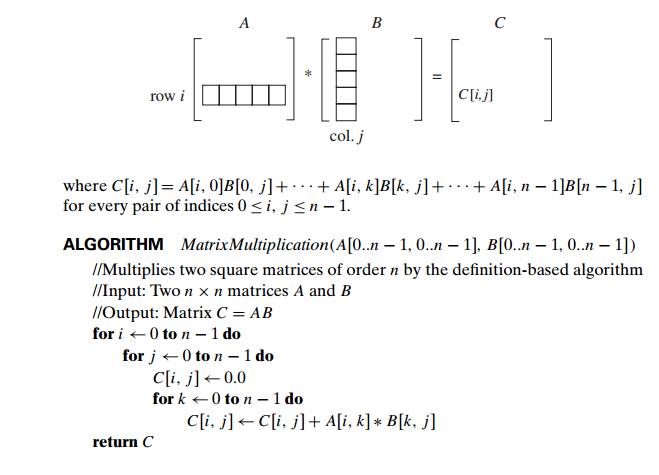
We
measure an input’s size by matrix order n. There
are two arithmetical operations in the innermost loop here—multiplication and
addition—that, in principle, can compete for designation as the algorithm’s
basic operation. Actually, we do not have to choose between them, because on
each repetition of the innermost loop each of the two is executed exactly once.
So by counting one we automatically count the other. Still, following a
well-established tradition, we consider multiplication as the basic operation
(see Section 2.1). Let us set up a sum for the total number of multiplications M(n) executed by the algorithm.
(Since this count depends only on the size of the input matrices, we do not
have to investigate the worst-case, average-case, and best-case efficiencies
separately.)
Obviously,
there is just one multiplication executed on each repetition of the algorithm’s
innermost loop, which is governed by the variable k ranging
from the lower bound 0 to the upper bound n − 1.
Therefore, the number of multiplications made for every pair of specific values
of variables i and j is
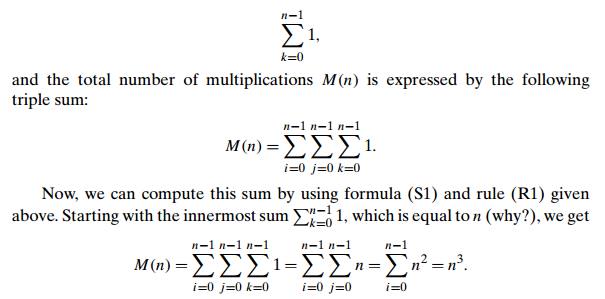
This
example is simple enough so that we could get this result without all the
summation machinations. How? The algorithm computes n2 elements
of the product matrix. Each of the product’s elements is computed as the scalar
(dot) product of an n-element
row of the first matrix and an n-element
column of the second matrix, which takes n
multiplications. So the total number of multiplica-tions is n . n2 = n3. (It is
this kind of reasoning that we expected you to employ when answering this
question in Problem 2 of Exercises 2.1.)
If we now
want to estimate the running time of the algorithm on a particular machine, we
can do it by the product

where cm is the
time of one multiplication on the machine in question. We would get a more
accurate estimate if we took into account the time spent on the additions, too:

where ca is the
time of one addition. Note that the estimates differ only by their
multiplicative constants and not by their order of growth.
You
should not have the erroneous impression that the plan outlined above always
succeeds in analyzing a nonrecursive algorithm. An irregular change in a loop
variable, a sum too complicated to analyze, and the difficulties intrinsic to
the average case analysis are just some of the obstacles that can prove to be
insur-mountable. These caveats notwithstanding, the plan does work for many
simple nonrecursive algorithms, as you will see throughout the subsequent
chapters of the book.
As a last
example, let us consider an algorithm in which the loop’s variable changes in a
different manner from that of the previous examples.
EXAMPLE 4 The
following algorithm finds the number of binary digits in the binary
representation of a positive decimal integer.
//Input:
A positive decimal integer n
//Output:
The number of binary digits in n’s binary
representation count ← 1
while n
> 1 do
count ← count + 1
n ← n/2
return count
First,
notice that the most frequently executed operation here is not inside the while loop but rather the comparison n
> 1 that
determines whether the loop’s body
will be executed. Since the number of times the comparison will be executed is
larger than the number of repetitions of the loop’s body by exactly 1, the
choice is not that important.
A more
significant feature of this example is the fact that the loop variable takes on
only a few values between its lower and upper limits; therefore, we have to use
an alternative way of computing the number of times the loop is executed. Since
the value of n is about halved on each
repetition of the loop, the answer should be about log2 n. The exact formula for the number
of times the comparison n > 1 will
be executed is actually log2 n + 1—the number of bits in the
binary representation of n
according to formula (2.1). We could also get this answer by applying the
analysis technique based on recurrence relations; we discuss this technique in
the next section because it is more pertinent to the analysis of recursive
algorithms.
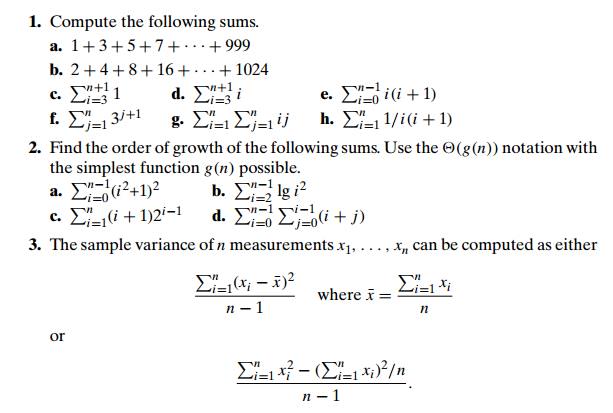
Find and
compare the number of divisions, multiplications, and additions/ subtractions
(additions and subtractions are usually bunched together) that are required for
computing the variance according to each of these formulas.
4. Consider the following algorithm.
ALGORITHM Mystery(n)
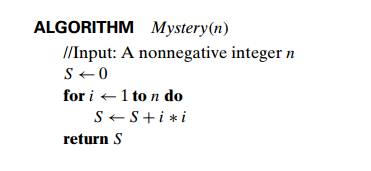
return S
What is
its basic operation?
How many
times is the basic operation executed?
What is
the efficiency class of this algorithm?
Suggest
an improvement, or a better algorithm altogether, and indicate its efficiency class.
If you cannot do it, try to prove that, in fact, it cannot be done.
5. Consider the following algorithm.
ALGORITHM Secret(A[0..n − 1])
//Input:
An array A[0..n − 1] of n real numbers minval ← A[0]; maxval ← A[0]
for i ← 1 to n − 1 do
if A[i] < minval minval ← A[i]
if A[i] > maxval maxval ← A[i]
return maxval − minval
Answer
questions (a)–(e) of Problem 4 about this algorithm.
6. Consider the following algorithm.
ALGORITHM Enigma(A[0..n − 1, 0..n − 1])
//Input:
A matrix A[0..n − 1, 0..n − 1] of
real numbers for i ← 0 to n − 2 do
for j ← i + 1 to n − 1 do if A[i, j ] = A[j,
i]
return false
return true
Answer
questions (a)–(e) of Problem 4 about this algorithm.
Improve the
implementation of the matrix multiplication algorithm (see Ex-ample 3) by
reducing the number of additions made by the algorithm. What effect will this
change have on the algorithm’s efficiency?
Determine the asymptotic
order of growth for the total number of times all the doors are toggled in the
locker doors puzzle (Problem 12 in Exercises 1.1).
9 Prove the
formula

either by
mathematical induction or by following the insight of a 10-year-old school boy
named Carl Friedrich Gauss (1777–1855) who grew up to become one of the
greatest mathematicians of all times.
10.Mental
arithmetic A 10×10 table is filled with repeating numbers on its diagonals as
shown below. Calculate the total sum of the table’s numbers in your head (after
[Cra07, Question 1.33]).
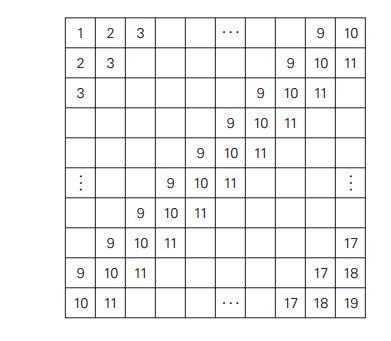
Consider the following
version of an important algorithm that we will study later in the book.
//Input:
An n × (n + 1) matrix A[0..n − 1, 0..n] of real numbers for i ← 0 to n − 2 do
for j ← i + 1 to n − 1 do for k ← i to n do
A[j,
k] ← A[j, k]
− A[i,
k] ∗ A[j,
i] / A[i,
i]
Find the time efficiency class of this algorithm.
What glaring inefficiency does this pseudocode contain and how can it be eliminated to speed the algorithm up?
12. von Neumann’s neighborhood Consider the algorithm that starts with a single square and on each of its n iterations adds new squares all around the outside. How many one-by-one squares are there after n iterations? [Gar99] (In the parlance of cellular automata theory, the answer is the number of cells in the von Neumann neighborhood of range n.) The results for n = 0, 1, and 2 are illustrated below.

13. Page numbering Find the total number of decimal digits needed for num-bering pages in a book of 1000 pages. Assume that the pages are numbered consecutively starting with 1.
Related Topics